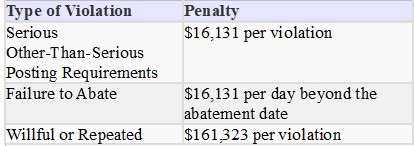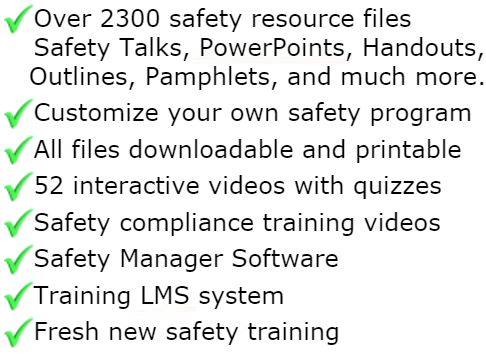
Forklift & Powered Industrial Truck Safety
Using forklifts to safely move material is a significant safety concern. During the movement of products and materials there are numerous opportunities for personal injury and property damage caused by improper forklift operations or safety procedures. Safety programs for forklifts, powered industrial tucks, hoists & lifting gear are essential.
Forklift Safety Training
Step 1 Review Information
OSHA Standard 1910.178 and equipment manufacturer's operator and maintenance manuals
Step 2 Review Information
Operators - Anyone who is expected to ever operate a forklift or other "Powered Industrial Truck" such as manlifts, pallett jacks, etc., must be training and certified as an operator.
Equipment - There are many different types of powered industrial trucks. Typically, these types of vehicles are known as forklifts or lift trucks. If your employees will be expected to operate several different types of powered industrial trucks, then training is required on the unique handling characteristics of the vehicles.
Step 3 - Define Training Methods
OSHA required that forklift training be conducted by a competent person. Your company decides the level of competency. The trainer must know the equipment, be able to conduct training and evaluate trainee performance. Training must consist of a combination of formal instruction and practical training.
Formal instruction may include lectures, conferences, classroom discussions, demonstrations, and written or oral tests. To make the training more understandable to the employee, consider using movies, slides, computers, video tapes and other visual presentations. being used.
A Forklift Safety or Powered Industrial Truck program is required by OSHA if your company has any mechanized-wheeled equipment for moving material or employees. OSHA's standard also covers motorized pallet jacks.
Ensure that the type motor or engine for each type forklift in service is compatible with the environment in which it will be used.
Refueling or recharging stations for forklifts must be designed with proper ventilation - petroleum or LP gas refueling areas must be outside - battery charging areas require a well ventilated area with eye-wash/showers and material for battery acid spill cleanup. Forklift Battery charging creates hydrogen gas which is highly explosive.
Forklift OPERATIONS
Look at the forklift operational environment for both the forklift and the operator. Select the type of forklift motor and classification that is compatible with potential and existing hazards.
Check paths of travel to ensure they are not restrictive and are well lit. Forklift traffic paths should be marked on the floor areas to warn pedestrians. Protect unguarded drop-offs and utility areas. Look at areas where forklifts must make corners - ensure stair landings or doorways do not exit blindly into forklift traffic paths.
Place signs and mirrors along traffic paths. Set and enforce a safe forklift speed limit both inside and outside.
Establish routine daily forklift operator inspections and documentation. Establish procedures for identification, removal from service, replacement and control of unsafe forklifts and equipment.
Install seatbelts on all seats and attachments for lanyards & harnesses for any equipment used to elevate a worker above floor level. All attachments must be authorized for the specific fork truck by the manufacturer. Label attachments to show with what equipment they can be used.
Shipping Docks - check all areas for forklift clearance. Conduct routine inspections of dock & bridge plates. Set up a key control system to prevent trailers from being pulled away from docks while loading with a forklift is in progress.
Purpose of Meetings
• Encourage awareness
• Promote participation
• Provide motivation
• Introduce new procedures
• Reinforce existing policies
Pre-Planning Whether a formal or informal meeting, being well prepared with an understanding of the topic will ensure that the training session time is not wasted. If you find yourself simply reading the material, you will probably loose their attention very quickly
Personalize It! If you want others to use the training you provide you must make it applicable to their situation and job conditions. Use examples from day to day operations.
Show & Tell. If the topic includes use of equipment such as locks, tags, safety glasses or tools, use these as props to show their proper use and the hazards of misuse.
Use Audience Knowledge. Many employees you will be teaching have years of experience. Keep them from getting bored by using active techniques such as, "John, tells us about the time.....".
Keep it Short. Most safety meeting topics can be completed in 15 to 20 minutes. Don't try to fill the time time.
Nuts & Bolts. Use a basic outline to keep your session flowing. An outline need only be reminder points to ensure you have covered all required areas. This will also help with a smooth opening and closing.
• Introduce yourself
• Introduce the topic
• Present your facts
• Discuss the applicable hazards
• Discuss hazard control
• Demonstrate the "How To"
• Ask questions during session
• Ask "What if...."
• Start a discussion• Summarize key points
Check Your Attitude! People will quickly pick up on the fact if you are just going through the motions because management says you must have a safety meeting. They will have less respect for you if you do not control the session as they know you should. Be positive, be animated.... allow your professional approach to catch on with others.
All materials in the members area for this topic index
Pre-Made Safety Materials Ready For Use
Created by experienced safety professionals & risk consultants. Saving you time, money, and risk of injuries.
95% of the work already done.
Below are the maximum penalty amounts, with the annual adjustment for inflation, that may be assessed after Jan. 15, 2024. (See OSHA Memo, Jan. 8, 2024).

**New OSHA HEAT 90 DAY**
>>Download Free HERE<<
**New 2024 OSHA 300 Form**
>>Download Free HERE<<
**Brand New**
Free with full membership subscription
Training LMS System
Ask The Safety Consultant
Safety Equipment Deal Finder

“SafetyInfo.com is the first go-to website for safety professionals and companies to use in establishing a solid safety program"
-Mike McKenzie, Certified Safety & Health Manager (CSHM), McSafety Solutions™
Note: You must have a full subscription to the Safety Library in order to use this material. Any use outside of your organization, for resell, or without an active membership is strictly prohibited and may result in prosecution under copyright infringement laws. Please contact us first, if you would be interested in reselling or using our materials for reproduction.
Inside the Members Library
Topic Index
Accident Prevention
Air Quality
Asbestos
Bloodborne Pathogens
Boilers
Chemical Safety
Compressed Gas
Confined Space
Construction
Construction Worksite
Cranes & Slings
Driver / Fleet Safety
Drug Free Workplace
Electrical
Emergency Management
Engineering Safety
Environmental
Equipment
Ergonomics
Fall Protection
Fire Safety & Prevention
First Aid
Flammable Materials
Forklifts
Hazard Communication
Hazardous Materials
Hearing Protection
Heat Stress
Hot Work
Housekeeping
Job Safety Analysis
Laboratory
Ladders
Lead
Lockout-Tagout
Machinery & Equipment
Material Handling
MSDS (SDS)
Medical & First Aid
Occupational Health
Office Safety
Off the Job Safety
Personal Protection
Process Safety
Record Keeping
Respiratory Protection
Silica Safety
Rules & Policies
Signs & Labels
Slips, Trips & Fall
Training
Terrorism Programs
Tool Safety
Vehicle & Driver
Violence Programs
Welding & Hot Work
Training Videos
Library Index
Training Materials
Videos/Courses
Talks
Articles
PowerPoint
Handouts
Training Overheads
Quizzes
Supervisor Briefs
Management Briefs
Safety Sessions
2 Minute OSHA Safety Talks
Pamphlets
First Aid Training
Supervisor Training
Hazardous Materials
Bomb Threat
Crossword Puzzles
Biological Agents
Forms & Documents
Forms
Checklists
Audit Guides
Inspections Guides
Signs & Labels
Environmental Audit Guides
Recordkeeping - OSHA 300
Sign & Label Maker
Safety Management Resources
Safety Manuals/Written Programs
Ergonomic Programs
Emergency Plans
Process Safety Management
Construction Safety
Occupational Health
Environmental
Topic Sheets
DOT Fleet-Driver
Hazardous Materials
Chemical Safety
Drug Free Workplace
Terrorism Programs
Development Guides
Safety Manager Software
Safety References & Graphics
Technical Safety Information
Posters
Topic & Fact Sheets
Development Information
Job Specific Safety Rules
Terrorism
Calculators
Safety Comic Strips
New Safety Training System
Schedule and train your employees with our materials. Add unlimited amount of employees. Record all progress and issue certificates. For group and individual training sessions.

GET INSTANT ACCESS
to THE MEMBERS LIBRARY
Safety materials created by safety professionals.
Access to the Safety Manager software.
Wide variety of safety videos and courses.
**Brand New** Safety Training Management System

